OmniStudio-Developer Practice Test
Updated On 18-Sep-2025
116 Questions
Refer to the exhibit below. What JSON from the DRGetContactDeteils action would display all six values correctlyshown? BlkCases is a Repeat Block, and the names of the elements are the same as the label names without spaces.
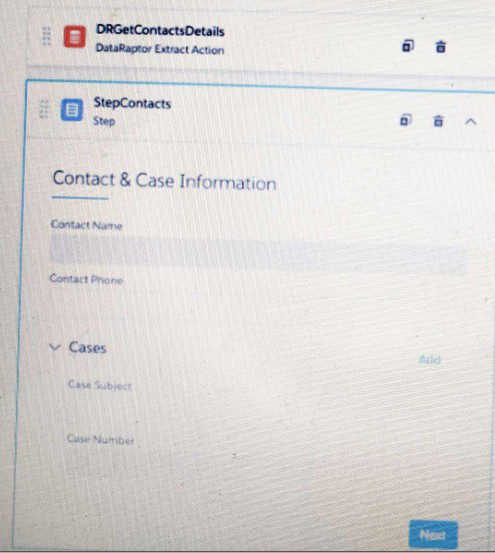
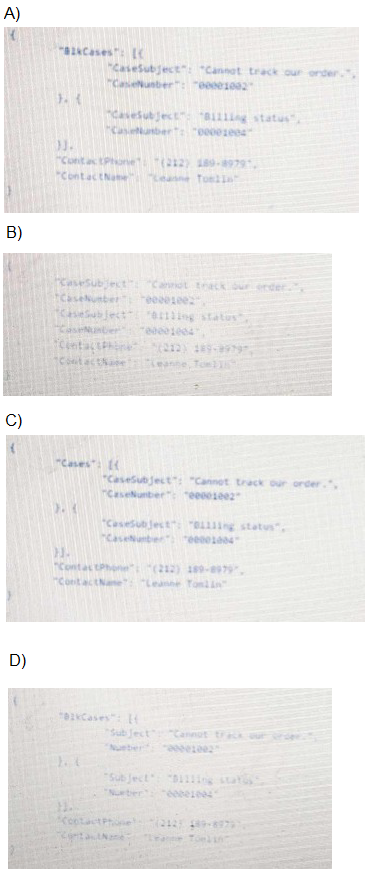
A. Option A
B. Option B
C. Option C
D. Option D
Explanation:
OmniScript repeat blocks use the block element’s API name as the JSON array key. A Repeat Block labeled “Cases” defaults to an API name of BlkCases, so the JSON must include a BlkCases array. Each array item needs properties matching the element names CaseSubject and CaseNumber, and the contact fields use ContactPhone and ContactName keys. Option A correctly shows:
{
"BlkCases":[
{ "CaseSubject":"Cannot track our order…","CaseNumber":"0000102" },
{ "CaseSubject":"Billing status","CaseNumber":"0000104" }
],
"ContactPhone":"(212) 189-8979",
"ContactName":"Leanne Tomlin"
}
This structure matches the canvas hierarchy and element API names.
Refer to the exhibit below. A developer has configured an Integration Procedure element with SEND/RESPONSE TRANSFORMATIONS as shown.
Alternatively, how could the developer configure Additional Input tosend exactly the same data? Assume that the developer checked Send Only Additional Input.
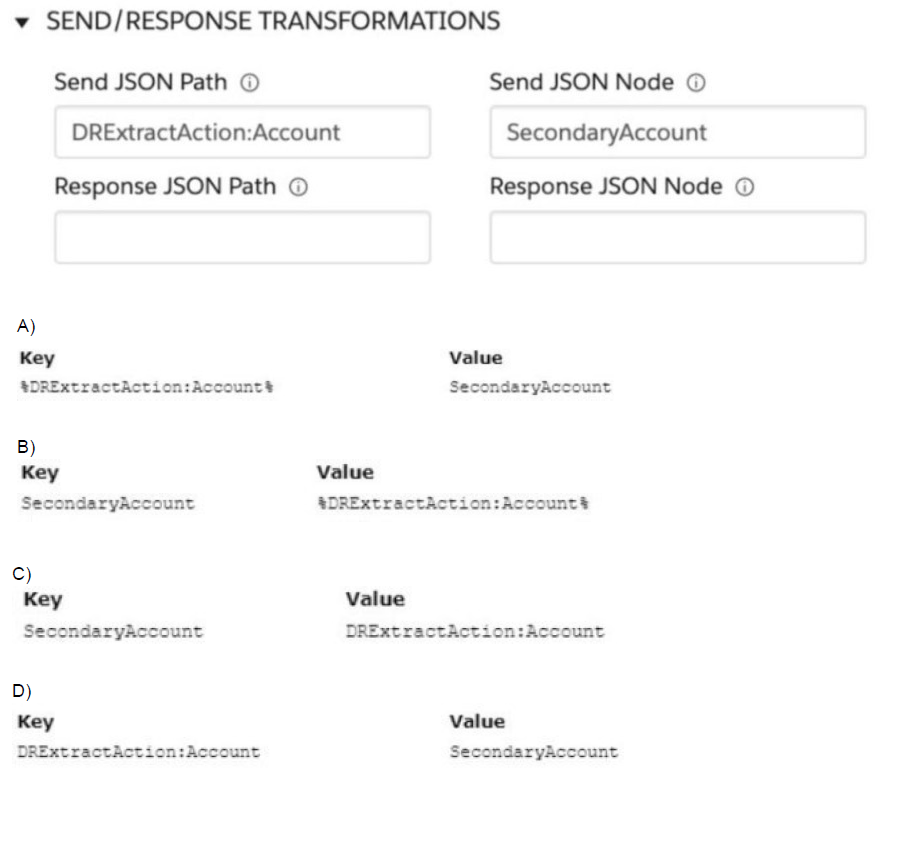
A. Option A
B. Option B
C. Option C
D. Option D
Explanation:
The Additional Input property allows the developer to specify additional input parameters to
be sent to the Integration Procedure element. The input parameters can be specified as a JSON object or as a list of key-value pairs. If the developer checked Send Only Additional Input, then only the input parameters specified in Additional Input are sent, and the SEND/RESPONSE TRANSFORMATIONS are ignored. Therefore, the developer needs to specify the same input parameters as in the SEND/RESPONSE TRANSFORMATIONS in Additional Input. Option C shows how to do this using a JSON object with two properties: “DBExtractAction:Account” and “DBExtractAction:SecondaryAccount”. The values of these properties are the same as in the SEND/RESPONSE TRANSFORMATIONS.
A developer needs to create a list of cases for an account in a single Datable in a FlexCard. Like the one shown below.
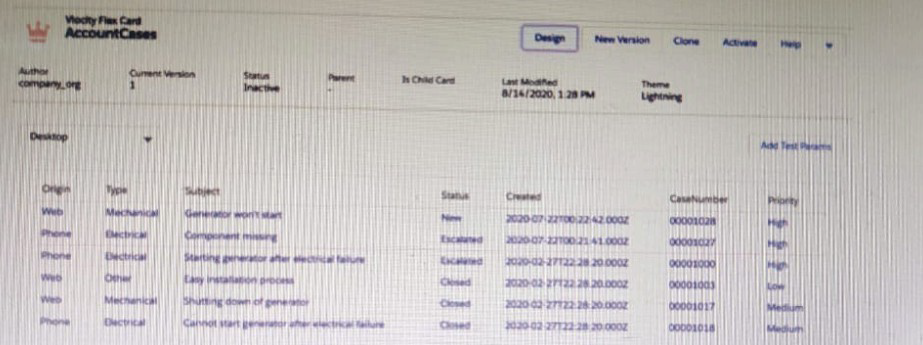
How can the developer configure the FlexCard to display the case records in this way?
A. Enable the record Looping feature on the data table elements
B. Select the Repeatable Mode propertyon thedata table elements
C. Enable the Repeat Records feature on the FlexCard Setup tab
D. Disable the Repeat Record feature on the FlexCard setup tab
Explanation:
The Repeatable Mode property on the data table elements allows the developer to display multiple records in a single data table. The Repeat Records feature on the FlexCard Setup tab is used to display multiple FlexCards for each record in a data source. The Record Looping feature on the data table elements is used to iterate over a list of records and perform actions on each record. The Overwrite Target for all Null input checkbox on the Account id field is used to overwrite the existing value in the target object with null if the input value is null.
Refer to the exhibit.
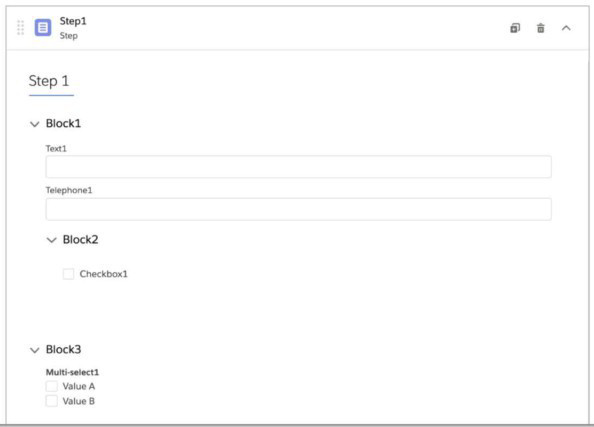
What JSON code correct represent the step in the OmniScript Structure panel shown?
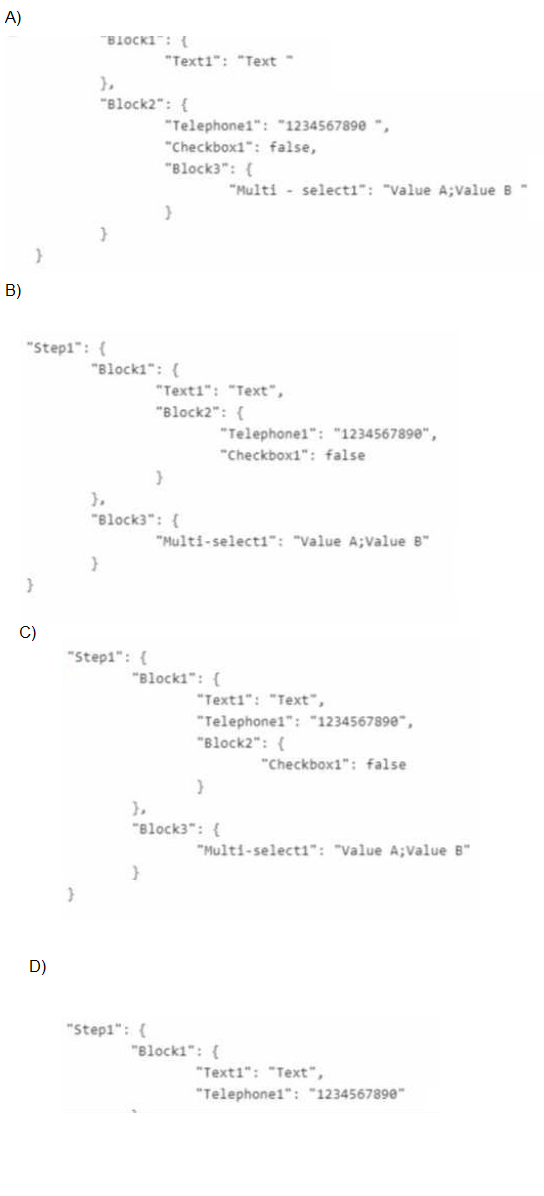
A. Option A
B. Option B
C. Option C
D. Option D
Explanation:
The JSON must mirror the OmniScript canvas hierarchy exactly. In the screenshot, Step1 contains Block1, which holds both Text1 and Telephone1, then a nested Block2 for Checkbox1, and finally a sibling Block3 for Multi-select1. Option C places Text1 and Telephone1 together under Block1, nests Checkbox1 under Block2 inside Block1, and defines Block3 separately under Step1—precisely matching the panel structure. Other options either nest Telephone1 incorrectly inside Block2 or omit the top-level Step1 key, so they don’t represent the canvas layout accurately.
A developer needs to transform contact data into a JSON array.
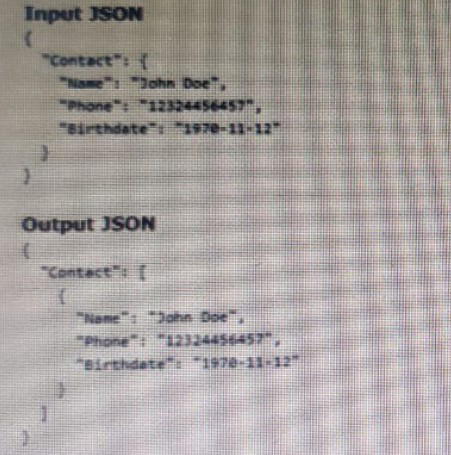
Given the input JSON shown above, what are two ways a developer could configure aDATA Raptortransform to achievethe expectedOutput JSON? Choose 2 answers
A. Use a formula LIST(Contact), and add the output of the formula as the input in the Transform tab.
B. Set the Input JSON path as List(Contact) and theOutput JSONPath as Contact.
C. Set the Input JSON Path as Contact the out JSON Path asContactandtheoutput Data type as List.
D. Set the input JSON Path as Contact and the OutPut JSON Path as List (Contact)
C. Set the Input JSON Path as Contact the out JSON Path asContactandtheoutput Data type as List.
Explanation:
DataRaptor Transform can emit arrays either by wrapping existing nodes in a List data type or by using the LIST() formula function. In option A, you create a formula field with LIST(Contact), which builds a one-element array, then map that formula result in your Transform inputs. In option C, you map the Contact node directly and set its output type to List, instructing DataRaptor to always render it as an array, even if only one element exists. Both methods produce the expected JSON array structure without resorting to invalid path syntax or unsupported functions in the mapping itself.
Reference:
OmniStudio DataRaptor Transform Action
| OmniStudio-Developer Exam Questions - Home |
| Page 2 out of 24 Pages |